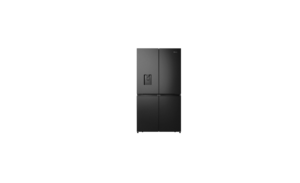Hisense WMS017M6XBE Use & Care Refrigerator
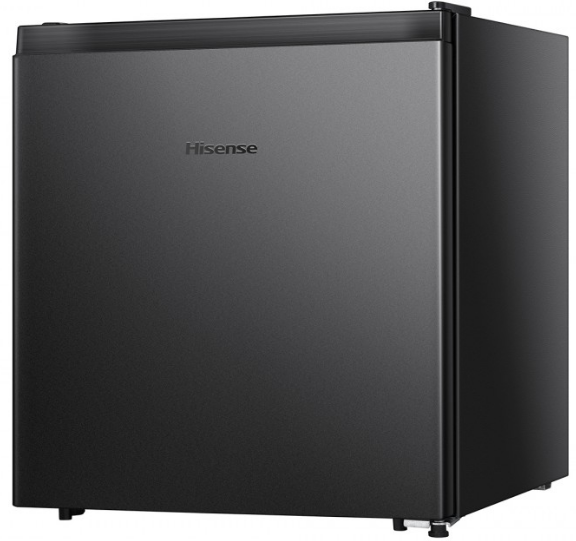
Read and Save Hisense WMS017M6XBE Use & Care Refrigerator User Manual.
Important safety instructions
For your safety and correct usage, please read these instructions carefully before using your new appliance to avoid unnecessary mistakes and accidents. Please ensure that all people using this appliance are familiar with its operation and safety features. Keep these instructions in a safe place for future reference and be sure that they are kept with the appliance if it is moved or sold so that everyone using it through its life will be properly informed on its correct appliance usage and safety. The manufacturer is not responsible for damages caused by misuse. The appliance is for indoor and domestic use only.
Electrical Information
- The appliance must be plugged into its own dedicated 115 Volt, 60 Hz., 15 Amp, AC-only electrical outlet. The power cord of the appliance is equipped with a three-prong grounding plug for your protection against electrical shock hazards. It must be plugged directly into a properly grounded three-prong receptacle. The receptacle must be installed by local codes and ordinances. Consult a qualified electrician. Avoid connecting the refrigerator to a Ground Fault Interruptor (GFI) circuit. Do not use an extension cord or adapter plug.
- Never unplug the refrigerator by pulling on the power cord. Always grip the plug firmly, and pull straight out from the receptacle to prevent damaging the power cord.
- Unplug the refrigerator before cleaning and before replacing a light bulb to avoid electrical shock.
- Performance may be affected if the voltage varies by 10% or more. Such damage is not covered under your warranty.
- Do not plug the unit into an electrical outlet controlled by a wall switch or pull cord to prevent the refrigerator from being turned off accidentally.
Fire Hazard
The appliance contains a small quantity of refrigerant (R600a) which is environmentally friendly but potentially flammable in the refrigerant circuit.
Safety for Children and Others Who are Vulnerable
- This appliance is not intended for use by persons (including children) with reduced physical, sensory, or mental capabilities, or lack of experience and knowledge unless they have been given supervision or instruction concerning the use of the appliance by a person responsible for their safety. Children should be supervised to ensure that they do not play with the appliance.
- Keep all packaging away from children to avoid the risk of suffocation.
- If you are discarding your old appliance, pull the plug out of the socket, and cut the connection cable (as close to the appliance as you can). Cut off the main plug and discard. Break off any old locks or latches as a safeguard and remove the door to prevent children playing from suffering an electric shock or from closing themselves inside it.
General safety and Daily use
- This appliance is intended to be used in household and similar applications such as:
- staff kitchen areas in shops, offices, and other working environments;
- farmhouses and by clients in hotels, motels, and other residential-type environments;
- bed and breakfast environments;
- catering and similar non-retail applications.
- Do not store flammable gases or liquids inside the appliance. There is a risk of an explosion.
- Do not operate any electrical appliances within the appliance (e.g. electric ice cream makers, mixers, etc.).
- When unplugging, always pull the plug from the main outlet. Do not pull on the cord.
- Do not place hot items near the plastic components of this appliance.
- Do not place food products directly against the air outlet on the rear wall.
- Frozen food must not be refrozen once it has been thawed out.
- Store pre-packaged frozen food by the frozen food manufacturer’s instructions.
Proper Disposal of your Refrigerator
Risk of Child Entrapment
Child entrapment and suffocation are not the only problems of the past. Junked or abandoned refrigerators are still dangerous – even if they are sitting “for just a few days”.If you are getting rid of your old refrigerator, please follow the instructions below to help prevent accidents.
Before you throw away your old refrigerator:
- Remove doors.
- Leave shelves in place so children may not easily climb inside.
- Have refrigerant removed by a qualified service technician.
Installation
Before installing, follow these important first steps.
Location
Position the appliance away from sources of heat such as stoves, radiators, direct sunlight, etc. Maximum performance and safety are guaranteed by maintaining the correct indoor temperature for the class of unit concerned, as specified on the rating plate. This appliance performs well o o from 12.8 to 43.3 C (55-110 F ). The appliance may not work properly if it is left for a longer period at a temperature above or below the indicated range.
IMPORTANT!
There is a need for good ventilation around the fridge for easy dissipation of heat, high efficiency of refrigeration, and low power consumption. For this purpose, sufficient clear space should be available around the fridge. There should be 75 mm (3 inches) separating the back of the fridge from the wall, at least 100 mm (4 inches) of space at its two sides, and a minimum of 100 mm (4 inches) from its top and a clear space up front to allow the doors to open 135. Appliances must not be exposed to rain. Sufficient air must be allowed to circulate in the lower rear section of the appliance, as poor air circulation can affect performance.
WARNING!!! The foam pad above the compressor is only suitable for transport and must be removed before Use.
Cleaning
- Wash any removable parts of the refrigerator interior, and exterior with mild detergent and warm water. Wipe dry. Do not use harsh cleaners on these surfaces.
- Do not use razor blades or other sharp instruments, which can scratch the appliance surface when removing adhesive labels. Any glue left from the tape can be removed with a mixture of warm water and mild detergent, or touch the residue with the sticky side of the tape already removed. Do not remove the serial plate.
Caution: Flammable refrigerant used! When handling, moving, and use of the refrigerator, make sure to avoid either damaging the refrigerant tubing or increasing the risk of a leak. - WARNING: Keep ventilation openings, in the appliance enclosure or the built-in structure, clear of obstruction.
- WARNING: Do not use mechanical devices or other means to accelerate the defrosting process, other than those recommended by the manufacturer.
- WARNING: Do not damage the refrigerant circuit.
- WARNING: Do not use electrical appliances inside the food storage compartments of the appliance, unless they are of the type recommended by the manufacturer.
Description of the Appliance
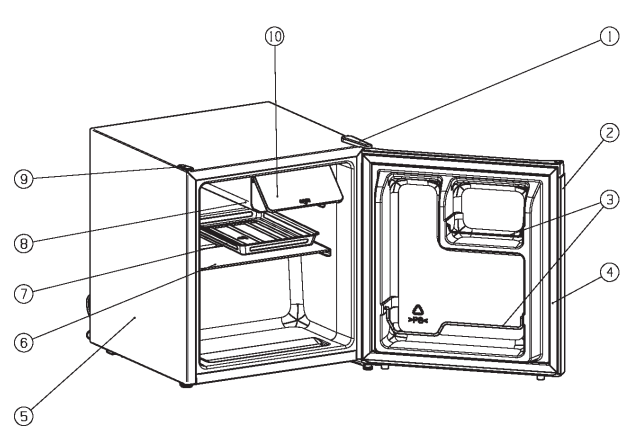
- upper hinge cover
- refrigerator door
- door rack
- gasket part
- cabinet
- glass shelf
- water drain tray
- roll bond evaporator
- screw hole cover
- chiller room cover
NOTE: This figure is only a sketch of the refrigerator, the actual product may differ from it.
State of California Proposition 65 Warnings:
WARNING: This product contains one or more chemicals known to the State of California to cause cancer.
WARNING: This product contains one or more chemicals known to the State of California to cause birth defects or other reproductive harm.
California (U.S.A.) Residents
WARNING: Cancer and Reproductive Harm – www.P65Warnings.ca.gov
Reversing the Door
The side at which the door opens can be changed from the right side (as supplied) to the left side if the installation site requires it.
Tools you will need:
- Wrench (5/16″,8mm)

- Philips Screwdriver

- Putty knife or thin-blade screwdriver

Before you start laying the refrigerator on its back to gain access to the base, you should rest it on soft foam packaging or similar material to avoid damaging the cooling pipes at the rear of the refrigerator.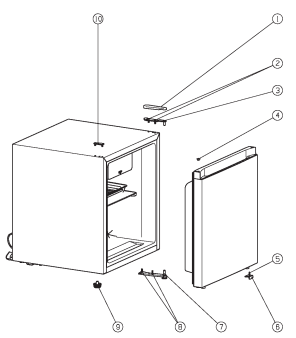
- upper hinge cover
- special flange self-tapping screw
- upper hinge
- hinge hole cap
- screw
- door stopper
- lower hinge
- special flange self-tapping screw
- bottom feet
- screw hole cover
- Open the refrigerator door and remove all fittings inside the door.
- Remove the upper hinge cover 1.
- Remove the two screws 2 that connect the upper hinge 3 on the right side of the cabinet top.
- Carefully lift the door and place it on a padded surface to prevent scratching.
- Remove the screw hole cover 10 and hinge hole cap 4 and transfer it to the uncovered hole on the right side of the unit. Be sure to press the button firmly into the hole.
- Remove the screw 5 attached to the door stopper then remove the door stopper, replace the door stopper to the other side of the door, and fix it with a screw.
- Remove the two screws 8 that hold the lower hinge 7 on the right side of the cabinet.
- Remove the bottom feet 9 and transfer it to the right side of the cabinet.
Temperature Control
Insert the plug of the connection lead into an outlet with protective earth contact. The temperature selector knob is located on the right side of the fridge.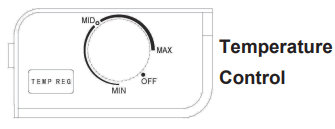
Setting OFF means
Turning the temperature control “OFF” position stops the cooling cycle, but does not shut off the power to the refrigerator. Turn the knob clockwise to turn the refrigerating unit on. The coldest setting is the “MAX” position. The unit operates automatically at the set position. If the unit is unplugged, power lost, or turned off, you must wait 3 to 5 minutes before restarting the unit. If you attempt to restart before this time delay, the refrigerator will not start.
- Setting MIN means:
Highest temperature, warmest setting. - Setting MAX means:
Lowest temperature, coldest setting. - Setting MID means:
Middle temperature, middle setting.
IMPORTANT!
Normally we advise you to select the setting of “MID”, if you want the temperature warmer or colder please turn the knob to a lower or higher setting accordingly. Though the unit is energy efficient, it is more efficient at lower position settings. High ambient temperatures (e.g. on hot summer days) and a cold setting on the temperature regulator (position “MAX” ) can cause the compressor to run continuously or even non-stop! When the refrigerator is in use, the compressor needs to be on and off normally to ensure its defrosting. Therefore, we should avoid setting the refrigerator’s notch too high(MAX). If you find the refrigerator frosts too much, please set the refrigerator’s notch lower.
Vacation Tips: if the appliance will not be used for several months:
- Remove all food.
- Unplug the power cord.
- Clean and dry thoroughly.
- Leave the door open slightly to prevent odor and mold growth.
Cleaning and Care
Warning!
- Remove the food from the appliance before cleaning. Store food in a cool place and keep well covered.
- Never clean the appliance with a steam cleaner. Moisture could accumulate in electrical components.
- Hot vapors can lead to the damage of plastic parts.
- The danger of electrical shock!
IMPORTANT!
- Ethereal oils and organic solvents can attack plastic parts, e.g. lemon juice or the juice from orange peel, butyric acid, and cleansers that contain acetic acid. Do not allow such substances to come into contact with appliance parts.
- Do not use any abrasive cleansers.
- Clean the appliance and the interior accessories with a cloth and lukewarm water. Commercially available dishwashing detergents may also be used.
- After cleaning, wipe with fresh water and a clean dishcloth.
- Accumulation of dust at the condenser increases energy consumption. For this reason, carefully clean the condenser at the back of the appliance once a year with a soft brush or a vacuum cleaner.
- Check the water drain hole on the rear wall of the refrigerator compartment.
- Clear a blocked drain hole with the aid of something like a soft peg. Be careful not to create any damage to the cabinet by sharp objects.
- After everything is dry, place the appliance back into service.
Defrosting Your Refrigerator
- The defrosting process is automatic. Melted frost flows into the drip tray and automatically evaporates.
- During the defrost cycle, water will accumulate in the drip tray. The drip tray may need to be emptied during the defrost cycle. Do not leave it unattended.
- After defrosting is complete, empty and wipe down the drip tray, as well as the interior of the refrigerator. You may now reset the refrigerator to the desired temperature and put the food back in.
Energy Saving Tips
- Do not place warm foods into the appliance. Allow warm foods to cool first. Do not install the appliance near cookers, radiators, or other sources of warmth. High ambient temperatures cause longer, more frequent operation of the compressor.
- To make the cooling system work efficiently, please make sure the side plates and back plate of the product are with some distance from the wall. It is strongly recommended that its back is 75 mm (3 inches) away from the wall, its sides at least have a space of 100 mm (4 inches) separately and the height from over its top is no less than 100 mm (4 inches).
- When the product works, please do not open the door too often or leave the door open any longer than necessary.
- Do not set the temperature any colder than necessary.
- The direct cooling refrigerator (with a freezer) needs to be defrosted when necessary. This will improve the cold transfer and reduce energy consumption.
- The sketch map shows the right combination of the shelves which can lead to more energy efficiency.
- If users adjust the combination, it may result in more energy consumption.
- Hisense WMS017M6XBE Use & Care Refrigerator User Manual.
Troubleshooting
Correcting Malfunctions
A malfunction may be caused by only a minor fault that you can rectify yourself using the following instructions. Do not perform any other work on the appliance if the following information does not assist in your specific case. Please keep upright at least 2 hours before use to prevent damage to the compressor.
IMPORTANT!
Repairs to refrigerators/freezers should only be performed by a qualified service technician. Improper repairs can give rise to significant hazards for the user. If your appliance needs repairing, please contact your specialist dealer or your local Service Center.
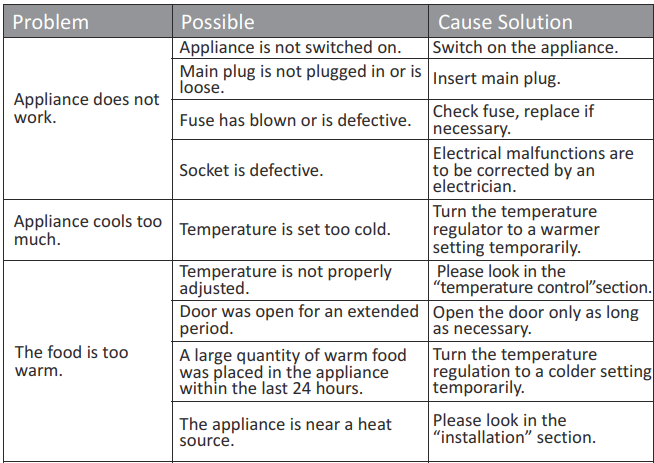
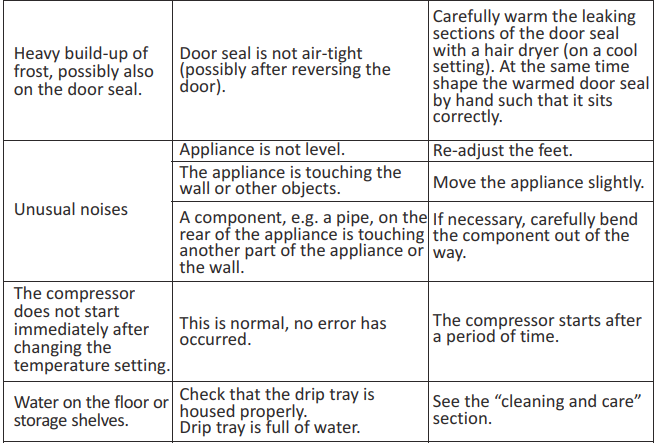
Disposal of the appliance
It is prohibited to dispose of this appliance as household waste.
Packaging materials:
Packaging materials with the recycle symbol are recyclable. Dispose of the packaging into a suitable waste collection container to recycle it. Before disposal of the appliance:
- Pull out the main plug from the main socket.
- Cut off the power cord and discard it with the main plug.





